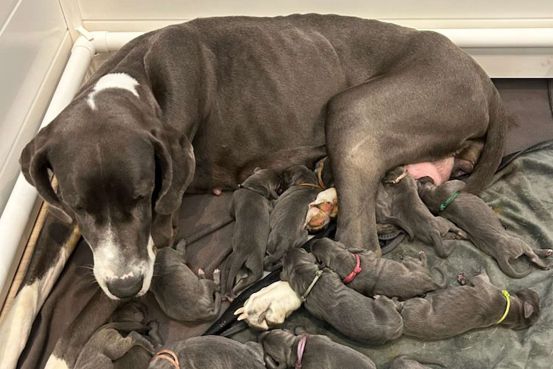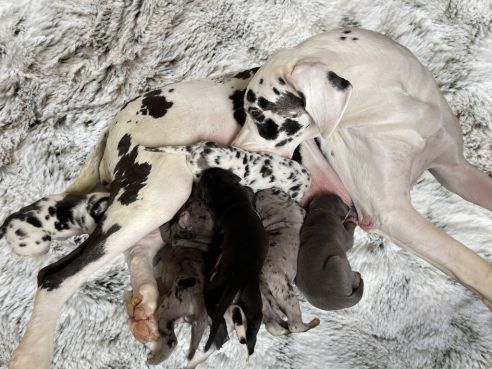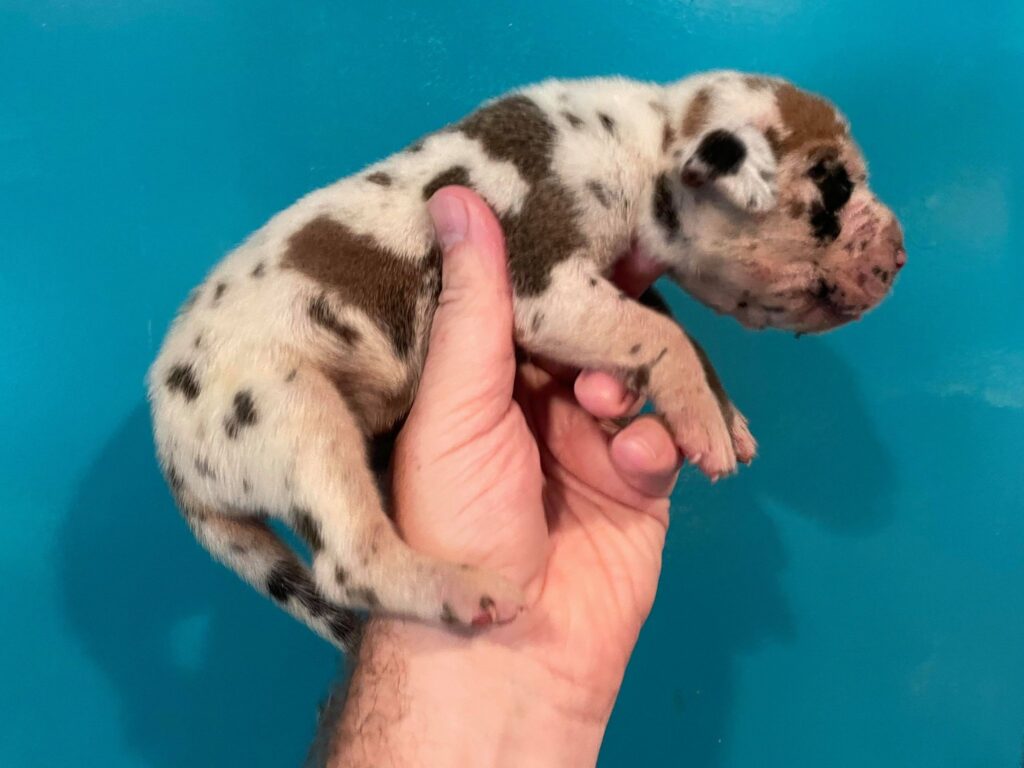Great Danes, known for their enormous size and gentle nature, are a popular breed among dog lovers. If you’re considering breeding Great Danes or you’re simply curious about the breed, one question you might ask is: how many puppies do Great Danes have? Find out the answer in the article below with Alibay Store.
How Many Puppies Do Great Danes Have?
On average, a Great Dane will have a litter of between 5 to 10 puppies. However, there are cases where a female (or “dam”) may give birth to as few as one puppy, or in rare instances, up to 15 puppies or more. Factors such as the dam’s age, health, genetics, and size all play a role in determining how many puppies she will have.
For first-time mothers, smaller litters are more common. As the dam ages and matures, subsequent litters often result in more puppies. Great Danes are a giant breed, and larger dogs tend to have larger litters compared to smaller breeds, but there is always variability.
How Many Puppies Do Great Danes Have? Factors Affecting Litter Size
While the average litter size of Great Danes ranges between 5 and 10 puppies, several factors can influence how many puppies a Great Dane will have:
- Age of the Dam: Typically, younger and older dams may have smaller litters. The optimal breeding age for a Great Dane is between 2 and 5 years old. As the dam ages, her fertility may decline, leading to smaller litters or complications during pregnancy.
- Genetics: Genetics play a significant role in determining litter size. If a Great Dane comes from a line of dogs that typically produce large litters, she is more likely to have a larger litter. Conversely, a dam from a line of smaller litters might have fewer puppies.
- Health and Nutrition: A healthy, well-nourished dam is more likely to have a larger and healthier litter. Poor nutrition or health issues, such as infections, parasites, or other medical conditions, can lead to smaller litters or complications during pregnancy and delivery.
- Breeding Practices: Proper breeding techniques can also influence the litter size. Breeders who ensure optimal timing for mating and who choose healthy, genetically sound parents tend to see larger, healthier litters.
- Size of the Dam: Larger Great Danes tend to have more puppies. The dam’s body size and weight can affect how many puppies she can carry and support during pregnancy.

The Whelping Process: What to Expect
The whelping process (the act of giving birth) can be a stressful time for both the dam and her owner. Knowing what to expect can help ease anxiety and ensure a smooth delivery for the puppies. The gestation period for Great Danes is typically 58 to 68 days, with most dams giving birth around day 63.
Here are some signs that a Great Dane is about to give birth:
- Nesting Behavior: In the days leading up to labor, the dam may become restless and start “nesting,” or preparing a place to give birth. She may dig, shred bedding, or look for a quiet, comfortable area to settle in.
- Decreased Appetite: Many dams will lose their appetite or become less interested in food as labor approaches.
- Temperature Drop: A dam’s temperature may drop below 100°F (37.8°C) about 24 hours before labor begins.
- Restlessness and Panting: Just before labor begins, the dam may become very restless and start panting heavily.
Once labor starts, the dam will usually give birth to a puppy every 30 to 60 minutes. The entire process can last several hours, depending on the size of the litter. After each puppy is born, the dam will usually instinctively clean the puppy and remove the amniotic sac.
Caring for Great Dane Puppies
Caring for newborn Great Dane puppies requires attention to detail and dedication, especially in the first few weeks of life. Here are some key aspects to consider when caring for a litter of Great Dane puppies:
1. Feeding
Newborn puppies rely entirely on their mother’s milk for the first few weeks of life. Great Dane puppies need to nurse frequently—every 2 to 3 hours in the first few days. It’s important to ensure that all puppies are nursing properly, especially in larger litters where competition for milk can be fierce.
If the dam is unable to produce enough milk, or if there are too many puppies for her to nurse adequately, supplemental feeding with puppy formula may be necessary. Always consult with a veterinarian to ensure you’re providing the right nutrition.
2. Temperature Control
Newborn puppies cannot regulate their body temperature on their own, so keeping them warm is crucial. Ensure that the whelping box is in a warm, draft-free area, and use heating pads or heat lamps to maintain a comfortable temperature. The ideal temperature for newborn puppies is around 85°F (29°C) for the first few days.
3. Socialization
Great Dane puppies will open their eyes and ears around 10 to 14 days after birth, and this is when their sense of the world starts to develop. Early socialization with their littermates and gentle human interaction is important for their emotional and behavioral development. As they grow, it’s important to expose them to different environments, sounds, and people to ensure they become well-adjusted adults.
4. Health Checkups
It’s important to schedule regular veterinary checkups for both the dam and her puppies during the first few weeks. The vet will check the puppies’ weight, development, and overall health. They will also give advice on vaccinations, deworming, and other preventive care measures.
When to Expect Full Development
Great Danes are a giant breed, and their growth rate is significant. Puppies will double their weight in the first week and continue to grow rapidly for the first few months. By the time they are 8 weeks old, Great Dane puppies are typically ready to be weaned off their mother’s milk and can start eating solid food.
Despite their rapid early growth, Great Danes are slow to mature and don’t reach their full adult size until they are 18 to 24 months old. During this time, it’s important to provide them with proper nutrition, socialization, and exercise to ensure they grow into healthy, well-adjusted adults.
Conclusion: Understanding Great Dane Litters
So, how many puppies do Great Danes have? While the average litter size for a Great Dane ranges from 5 to 10 puppies, various factors, such as the dam’s age, genetics, and health, can influence the size of the litter. Caring for a litter of Great Dane puppies requires attention, proper nutrition, and a commitment to ensuring their healthy development.
If you’re a proud Great Dane owner or breeder, be sure to check out our selection of Great Dane Dog at Alibay Store to provide your gentle giant with the perfect feeding solution tailored to their size and needs!





